In this competitive digital world, staying ahead of your competitors is crucial for your online success.
How to stay ahead of competitors?
One proven strategy is to learn from your competitors, understand what they are doing, and identify what will help you compete effectively with them.
This is known as competitor analysis, and it can help you refine your strategy.
For that, Semrush provides a Semrush Competitor Analysis Tool. I'm using this tool to analyze my competitors in my niche and improve my strategies.
In this blog, let's learn how to analyze competitors using Semrush step-by-step. It is a beginner-friendly guide.
Dig Deeper!
What is Competitive Analysis?
Competitive analysis is a process of understanding the competitor's strategies and analyzing their marketing methods.
It includes analyzing their content strategy, top keywords, quality backlinks, and overall website analysis.
Overview Of Semrush Competitor Analysis Tool
Semrush provides you with a few tools to help you understand your competitors. Let's see what they are.
- Domain Overview
- Traffic Analytics
- Organic Research
- Keyword Gap
- Backlink Gap
- Backlink Analytics
These are the tools that Semrush has to analyze your competitors.
How to do Competitor Analysis in Semrush? - Follow the Steps
Follow each line carefully to understand it clearly.
Let's start the Semrush competitive research.
Step 1: Semrush Domain Overview:
For example, ComTechies is one of your competitors. Now, enter the Comtechies URL and click search.
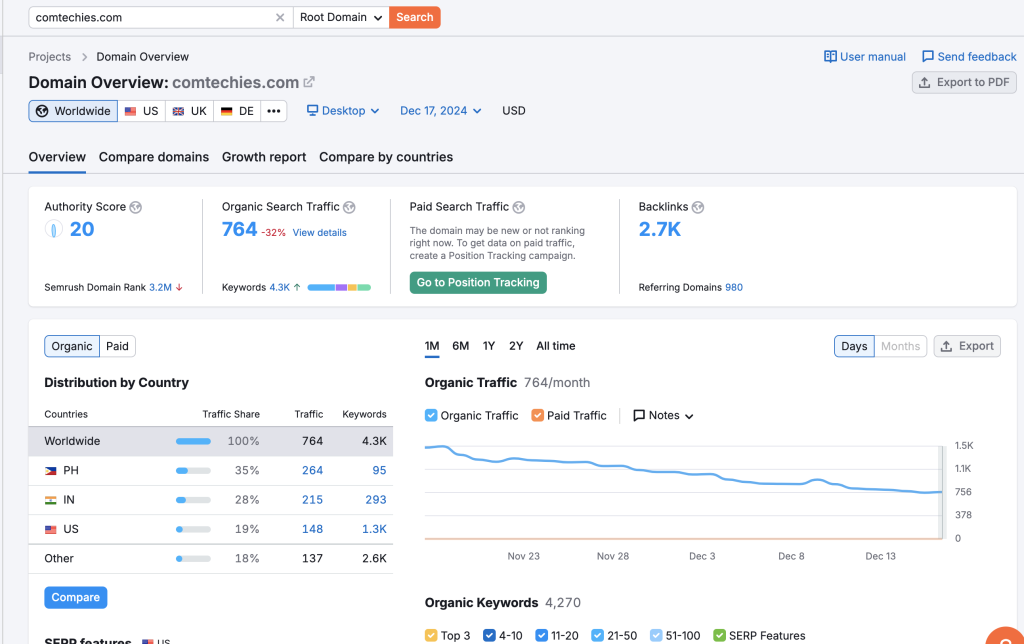
This is the first page you will get.
Here, you can view the authority score, organic search traffic, no.of backlinks, organic traffic by graph view, and traffic from the countries.
Now scroll down to see the competitor's top organic keywords, keywords by intent, organic position distribution of keywords in SERPs, and branded vs. non-branded traffic.
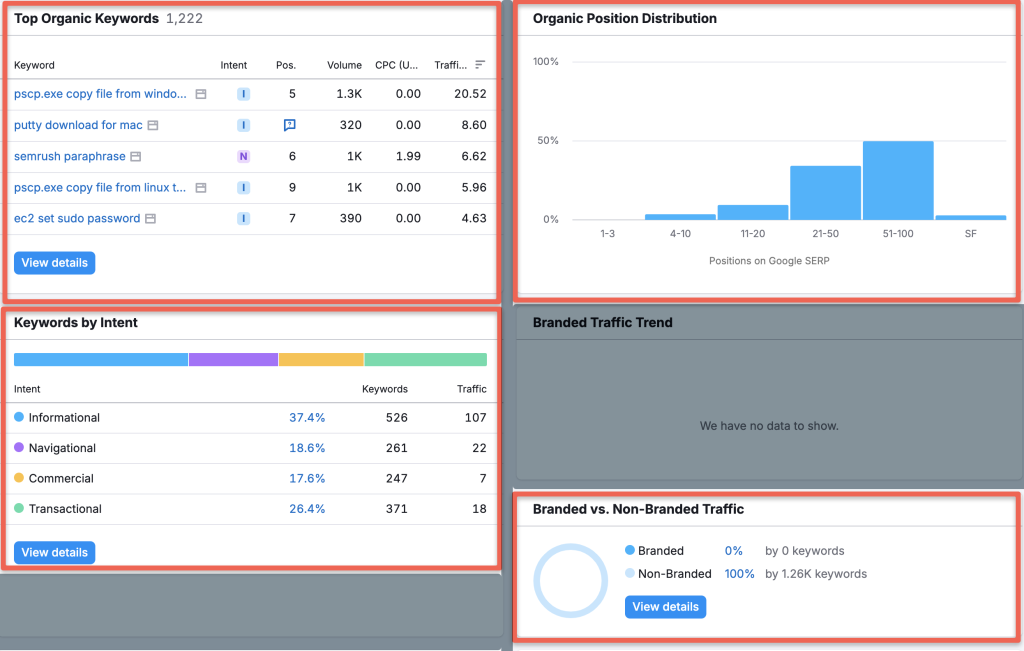
This will help you take the best-performing keywords and create new content for your website that is better than your competitor's.
In the domain overview, you can find out and benefit from all of these. Here is the full guide for Semrush Traffic Analytics.
Step 2: Semrush Organic Research
Semrush Organic Research is somewhat similar to the domain overview.
What insight do you get from this organic research? Let's see.
You can view the number of keywords, traffic cost, and organic keyword trends in this.
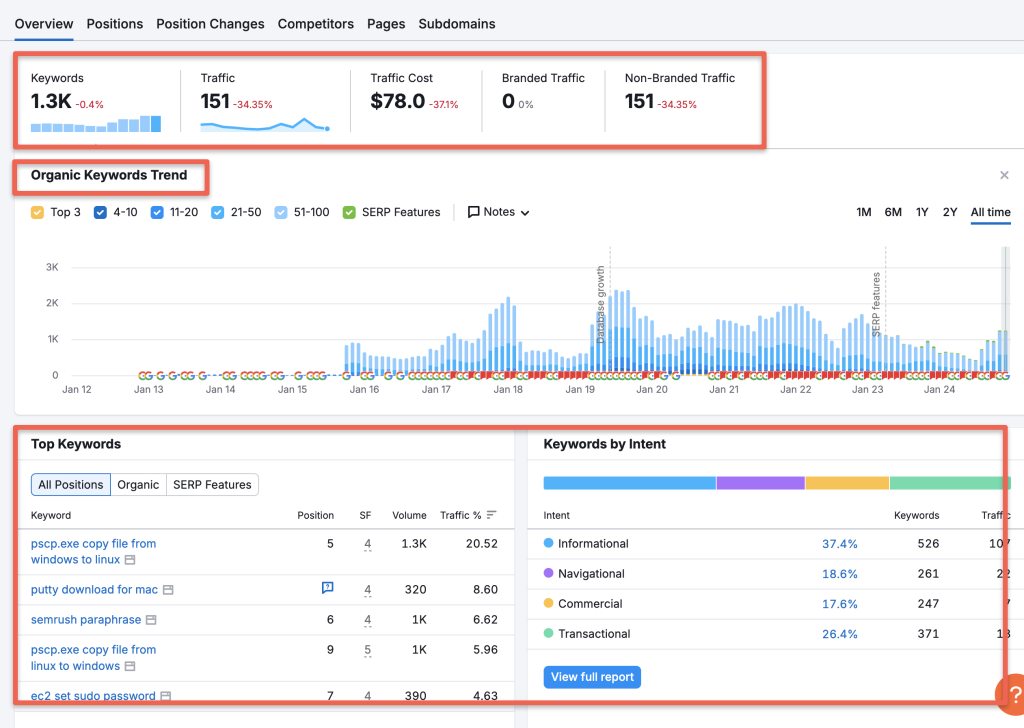
Now, come to the positions section.
Here, you can see your competitor's organic keywords. It shows you the keywords, intent, keyword position on the SERPs, traffic, traffic percentage, volume, KD%(Keyword Difficulty), and page URL.
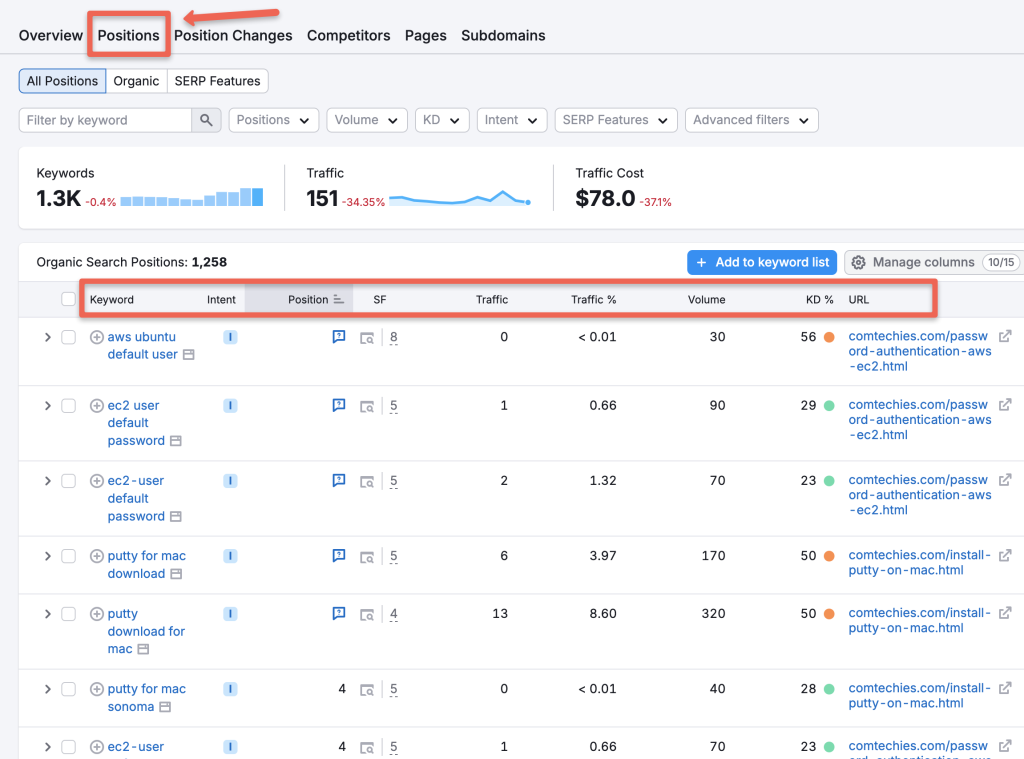
Now go to the competitor's section!
Here, you can know and view your organic competitors. Also, it shows the competition level, common keywords, SE keywords, traffic, costs, and paid keywords.
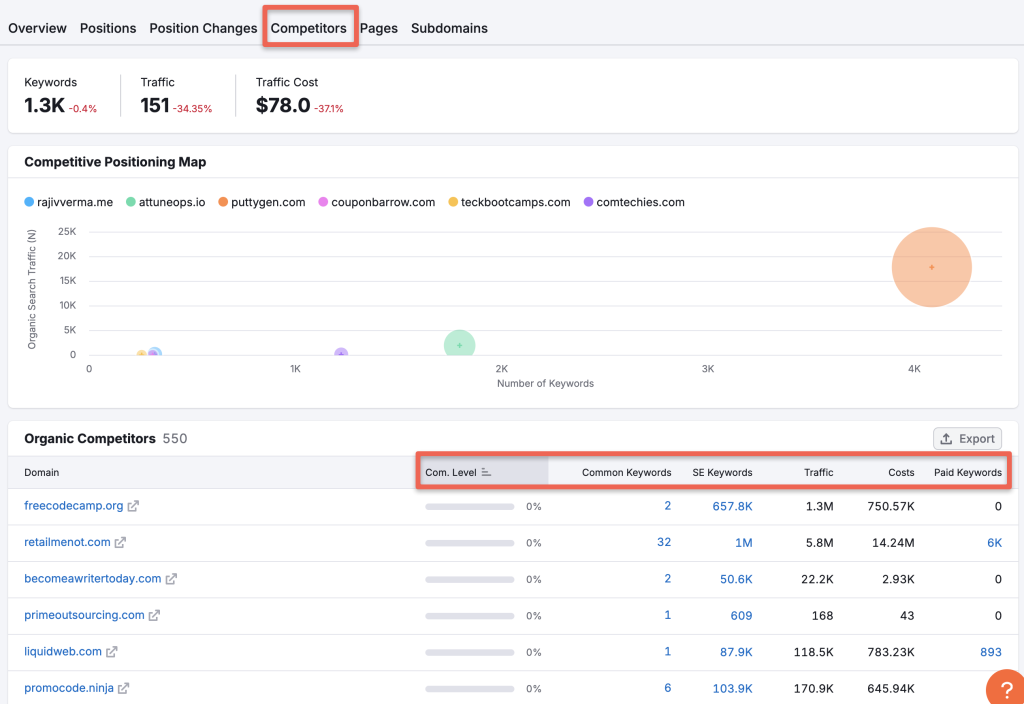
Let's see the little detailed explanation of each one:
- Competition Level - This metric is calculated based on each competitor's keywords and the common keywords of both competitors. If websites have a large number of common keywords, they can be considered competitors.
- Common Keywords - The number of common keywords in an analyzed domain and a given competitor ranking in Google's top 20 organic search results.
- SE keywords - The number of keywords bringing users to a domain via Google's top 100 organic search results.
- Traffic - The estimated traffic driven to an analyzed domain with a given keyword over a specific period.
- Costs - The total cost of all traffic driven to an analyzed domain with a given keyword over a specific period.
- Paid Keywords - The number of keywords a given domain buys in Google Ads for ads appearing in paid search results.
Step 3: Semrush Keyword Gap
How do you find the keyword Gap between you and your competitor using Semrush Keyword Gap, too?
Let's find out how!
You can compare five competitors at a time. For instance, I will compare ComTechies and Semrush.
In this section, you can view the shared, missing, weak, strong, untapped, and unique keywords by comparing them to your competitors.
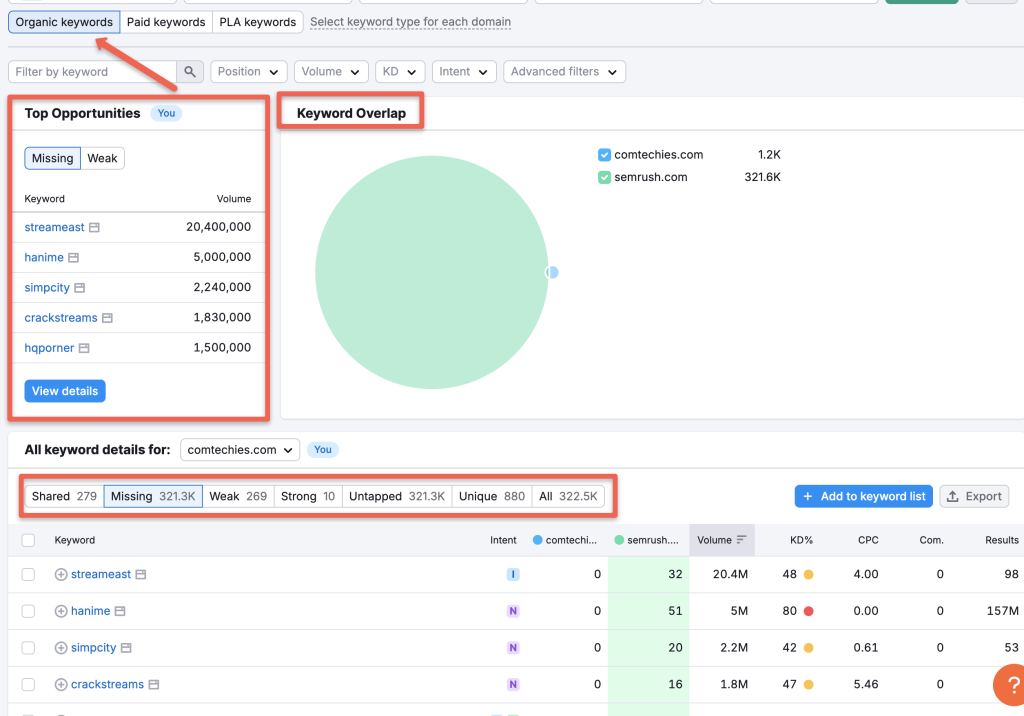
These are all organic keywords of your competitors. Here is a little explanation of each:
- Shared Keywords - Keywords for which each of the entered domains has rankings.
- Missing Keywords - Keywords for which the domain doesn't have rankings, but all of the other entered competitors do.
- Weak Keywords - Keywords for which the domain ranks lower than any of the other entered competitors.
- Strong Keywords - Keywords for which the domain has better rankings than any of the other entered competitors.
- Untapped Keywords - Keywords for which the domain has no rankings but at least one of the other competitors does.
- Unique Keywords - Keywords for which the domain has rankings but other entered competitors do not.
Likewise, you can view it for Paid Keywords.
Step 4: Semrush Backlink Gap
In keyword gap analysis, we identify keywords that are not on your website. Likewise, in a backlink gap analysis, you can locate a quality backlink that is not on your website but is present on your competitor's.
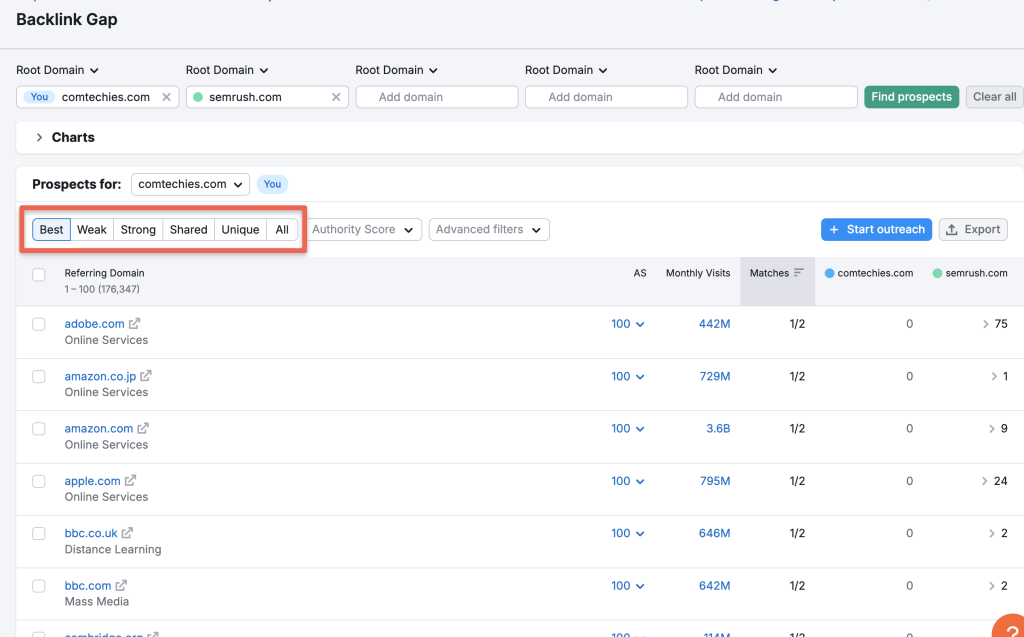
Step 5: Semrush Backlink Analytics
Now, you have the backlink domains from your competitors. Now, click the domain to analyze the backlinks.
For example, I took the Amazon domain from my competitor.
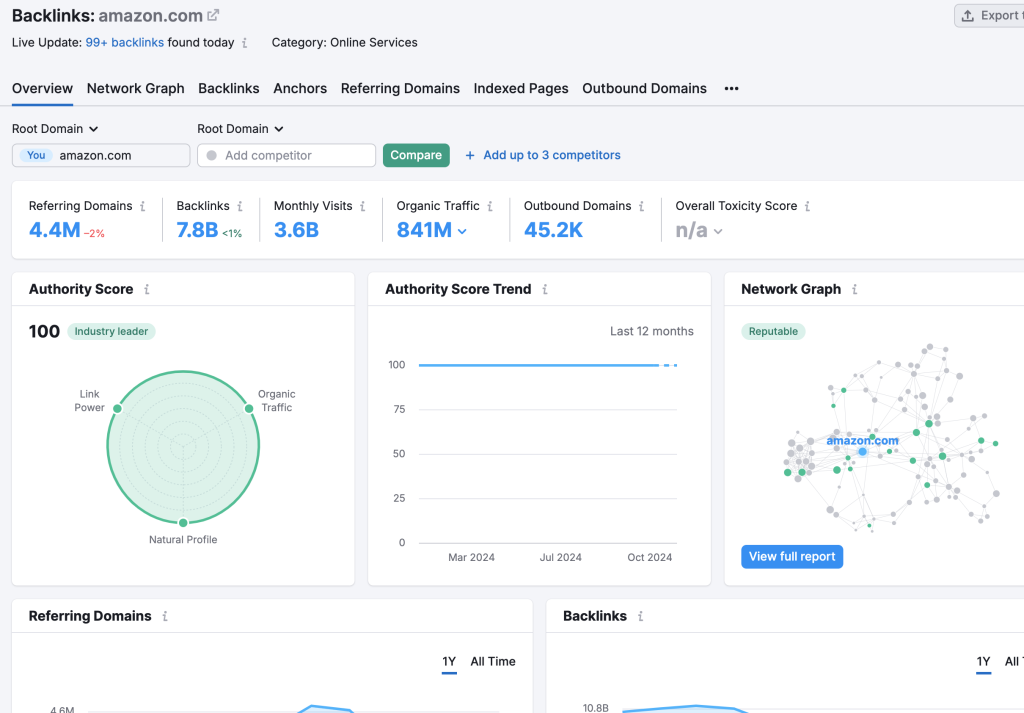
It's the quality link to outreach if you are a niche like Amazon.
This Semrush Backlink Analytics tool is the best tool to find quality backlinks for your site; just use it.
If you want to try Semrush without breaking your bank account, try the Semrush free trial to know its features and experiment for yourself.
What are the Key Metrics to Focus on During Competitor Analysis?
When analyzing competitors using Semrush, note a few key metrics that can help improve your website's visibility, traffic, and overall strategy.
First, note their traffic source and volume of website traffic using the Semrush traffic analytics tool.
It will show you how much traffic your competitors are getting and where they are getting more traffic.
This helps you know which works well for your site.
The second is to identify the top-performing organic keywords from your competitors using the Semrush domain overview tool.
You can use it on your website to increase organic traffic with high-quality content.
The third step is to analyze the backlink quality of your competitors using the Semrush backlink analytics tool.
Use it to find high-quality backlinks from reputable sites that link to your competitors, and avoid poor-quality backlinks.
Because not every backlink on your competitor is quality, so pick the right and quality links.
Fourth, try to understand your competitor's most engaging content and analyze it, such as why it's receiving more engagement, what makes it unique, and so on.
If you find it.
Then, try to use it in your content as well, which will help you gain organic traffic and engagement.
That's it!
These are the key metrics to focus on during competitor analysis using Semrush.
Tips to use the Gained Data from Semrush Competitor Analysis
Now, let's learn to implement the data gained from competitive research using Semrush in your content and website.
1. Improve the Content:
You got the top-performing keyword from your competitor, right?
Yes, those keywords show which ones are more searched and what your audience needs. Now, it's time to implement your content or create new content around the keyword you got.
If you have already written a blog about the keyword, then add more details, integrate relevant keywords, and structure the content with more valuable information.
If you haven't targeted this keyword yet, create new content with it.
Target every keyword and topic your competitors use and provide in-depth content and new insights that go beyond what they offer.
If you do it in the right way, then you have a high chance of outranking your competitors.
2. Target Quality Backlinks:
With Semrush backlink analytics, you can find reputable backlink sites on your competitors' sites.
Now, think about why they are linking to your competitor's website, what the reason is, what they provide, and so on.
If they provide a real informative post, an in-depth guide, a valuable audience resource, and shareable content.
If so, then create content incorporating all this and add your insights as well.
After creating it, reach out to the domains you picked and explain how your content adds value to them.
For example, if they link to your competitor's guide on 'Semrush Tutorial For Beginners', add more insights and an in-depth guide to let them know how it will be useful to their audience.
Just mention why linking to your content is valuable and workable.
3. Adjust SEO Strategy:
You analyzed the keyword gap using Semrush, which is not targeted at your website, but the particular keyword that is getting decent traffic on your competitor's website.
This means you have a gap in your SEO strategy, so be sure to include it in your content.
By integrating your content, you can increase visibility and drive more traffic to your website.
After including the keywords, use the Semrush Position Tracking(keyword tracker) tool to track the performance in SERPs(Search Engine Result Pages).
Why is Competitor Analysis Important?
Competitor analysis is a crucial skill in business and marketing. Let's look into why it is important.
1. Identify Opportunities:
By analyzing your competitors, you can identify areas that are not performing well and not providing the right value to your audience.
For example, if your competitor has a content gap, it's a plus for you to improve your marketing content to attract the audience.
So we can gain new customers and visibility.
2. Understand Market:
With competitor analysis, you can understand the strengths and weaknesses of your competitors' strategies.
By analyzing it, you can implement only the right strategy and avoid the mistakes they make.
Observing market trends and changes in your competitors' strategies helps you adapt to them, which in turn helps you compete with your competitors.
3. Improve Strategy:
If your competitor's content or strategy is successful, you can adopt it or use it as inspiration to enhance your own.
So, competitor analysis is a really important part of your business and marketing strategy to gain more customers in your industry.
Semrush's competitive research tools will provide you with the right data to focus on improving your business.
Conclusion
In this blog, I provide a detailed guide on how to conduct competitor analysis using Semrush. I hope you understand how to do competitor analysis in Semrush now.
Competitor analysis is crucial for enhancing traffic and visibility, staying ahead of your competitors, and effectively competing with them.
Now, it's your turn to do competitor analysis with Semrush. Use the Semrush Coupon to get it at a low cost with the official discount provided by Semrush.
If you have any questions related to this guide.
Also, get to know about 10 things you can do with a free Semrush account.

